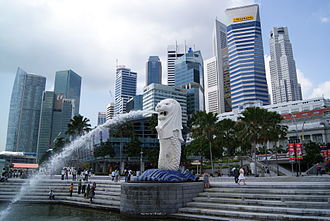
The reclamation of land from surrounding waters is used in Singapore to expand the city-state's limited area of usable, natural land. Land reclamation is most simply done by adding material such as rocks, soil and cement to an area of water; alternatively submerged wetlands or similar biomes can be drained.
In Singapore the former has been the most common method until recently, with sand the predominant material used. Due to a global shortage and restricted supply of the required type of sand (river and beach sand, not desert sand), Singapore has switched to polders for reclamation since 2016 — a method from the Netherlands in which an area is surrounded by a dyke and pumped dry to reclaim the land.
Land reclamation allows for increased development and urbanization,[1] and in addition to Singapore has been similarly useful to Hong Kong and Macau. Each of these is a small coastal territory restrained by its geographical boundaries, and thus traditionally limited by the ocean's reach. The use of land reclamation allows these territories to expand outwards by recovering land from the sea. At just 719 km2 (278 sq mi), the entire country of Singapore is smaller than New York City. As such, the Singaporean government has used land reclamation to supplement Singapore's available commercial, residential, industrial, and governmental properties (military and official buildings). Land reclamation in Singapore also allows for the preservation of local historic and cultural communities, as building pressures are reduced by the addition of reclaimed land.[2] Land reclamation has been used in Singapore since the early 19th century, extensively so in this last half-century in response to the city-state's rapid economic growth.[3] In 1960, Singapore was home to fewer than two million people; that number had more than doubled by 2008, to almost four and a half million people.[4] To keep up with such an increase in population (as well as a concurrent surge in the country's economy and industrialization efforts), Singapore has increased its land mass by 22% since independence in 1965, with land continuously being set aside for future use.[5][6] Though Singapore's native population is no longer increasing as rapidly as it was in the mid-twentieth century, the city-state has experienced a continued influx in its foreign population,[7] resulting in a continued investment in land reclamation by the government. The government thus plans to expand the city-state by an additional 7-8% by 2030.[5]
- ^ R. Glaser, P. Haberzettl, and R. P. D. Walsh, "Land Reclamation in Singapore, Hong Kong, and Macau," GeoJournal (August 1991), accessed February 16, 2017.
- ^ Tai-Chee Wong, Belinda Yuen, and Charles Goldblum, ed., Spatial Planning for a Sustainable Singapore (Springer Science + Business Media B.V., 2008), 26.
- ^ Glaser, "Land Reclamation".
- ^ Wong, Spatial Planning. VII.
- ^ a b "Such Quantities of Sand," The Economist. February 26, 2015.
- ^ Wong, Spatial Planning. 120–21.
- ^ Wong, Spatial Planning. 23.